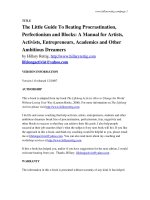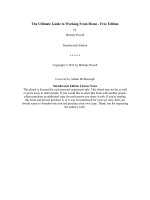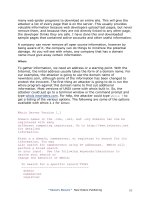No Holds Barred Fighting: The Ultimate Guide to Conditioning Elite Exercises and Training for NHB Competition and Total Fitness pot
Bạn đang xem bản rút gọn của tài liệu. Xem và tải ngay bản đầy đủ của tài liệu tại đây (7.44 MB, 257 trang )
No Holds Barred Fighting:
The Ultimate Guide
to Conditioning
Elite Exercises and Training
for NHB Competition and Total Fitness
Mark Hatmaker
TRACKS
Tracks Publishing
San Diego, California
Photography by Doug Werner
No Holds Barred Fighting:
The Ultimate Guide to Conditioning
Mark Hatmaker
Tracks Publishing
140 Brightwood Avenue
Chula Vista, CA 91910
619-476-7125
www.startupsports.com
All rights reserved.No part of this book may be reproduced or trans-
mitted in any form or by any means, electronic or mechanical,
including photocopying, recording or by any information storage
and retrieval system without permission from the author,except for
the inclusion of brief quotations in a review.
Copyright © 2007 by Doug Werner
10 9 8 7 6 5 4 3 2 1
Publisher’s Cataloging-in-Publication
Hatmaker, Mark.
No holds barred fighting : the ultimate guide to
conditioning elite exercises and training for NHB
competition and total fitness / Mark Hatmaker ;
photography by Doug Werner.
p. cm.
Includes index.
LCCN 2007905538
ISBN-13: 978-1-884654-29-9
ISBN-10: 1-884654-29-0
1. Hand-to-hand fighting. 2. Mixed martial arts.
3. Physical education and training. I.Werner, Doug,
1950- II.Title.
GV1111H338 2007 796.81
QBI07-600209
TRACKS
PUBLISHING
Fighting Books by Mark Hatmaker
No Holds Barred Fighting:
The Ultimate Guide to Submission Wrestling
More No Holds Barred Fighting:
Killer Submissions
No Holds Barred Fighting:
Savage Strikes
No Holds Barred Fighting:
Takedowns
No Holds Barred Fighting:
The Clinch
No Holds Barred Fighting:
The Ultimate Guide to Conditioning
Boxing Mastery
Books are available through major bookstores
and booksellers on the Internet.
Warning label
Submission wrestling includes contact and can be
dangerous. Use proper equipment and train safely.
Practice with restraint and respect for your part-
ners. Drill for fun, fitness and to improve skills. Do
not fight with the intent to do harm.
Special thanks from the author
To all the empirical minds in fight conditioning who have influ-
enced this work in major and minor ways. A brief list includes
Otto Arco, Georges Hebert, Scott Helvonston, John Jesse, Gina
Kolata and Jerry Robinson. There are many, many others, but
these names were at the forefront of my mind while compiling
this work.
Also, where would any book be without a little sentimentality?
I’ve resisted the urge in the previous manuals, but I guess the
ramparts have crumbled.
Thanks to my wife Kylie, for everything and then some.
Thanks to my good friend (“good friend” is too mild) Mitch
Thomas, who has been extremely supportive in all endeavors.
Thanks to Kory Hays for taking so much abuse over the years.
And last but not least, as you would not be able to read this
portion without his contribution, thanks to Doug Werner. A true
gentleman who took a chance. I gained a publisher and a
friend.
Tired of sentimentality? Probably. Let’s go to work.
Acknowledgements
Phyllis Carter for editing
Jackie Smith for image processing
Contents
How to use the NHB manuals 6
Intro 7
1 Concepts 13
2 Breathing 29
3 Counting 37
4 Warm-up 41
5 Body-weight exercises 49
6 Hinge group. Exercises for the abdominal girdle 51
7 Power group. Exercises for the legs 69
8 Pushing group. Exercises for the upper body 79
9 Pulling group. Exercises for the upper body 91
10 Fifth limb. Exercises for the neck 97
11 Dumbbell / kettlebell 103
12 Explosiveness / agility 143
13 Barbell 187
14 Grip 215
15 Cardio grinders 219
16 Flexibility. Stretching exercises 223
17 Menus. When to exercise 235
18 R and R. When to rest 239
19 Fuel. What to eat 243
Resources 248
Index 250
6
How to use the NHB (No Holds Barred) manuals
This book and the others in this series are meant to be used in
an interlocking synergistic manner where the sum value of the
manuals is greater than the individual parts. Our goal with each
manual is to focus on a specific aspect of the twin sports of
NHB/submission wrestling and to give thoughtful consideration
to the necessary ideas, tactics and strategies pertinent to that
facet of focus. We are aware that this piecemeal approach may
seem lacking if one only consumes one or two manuals, but we
are confident that when three or more manuals have been
studied, the overall picture or method will reveal itself.
Since the manuals are interlocking, there is no single manual in
the series that is meant to be complete in and of itself. For
example, although
No Holds Barred Fighting: Savage Strikes
is
a thorough compendium on NHB/self-defense striking, it is bol-
stered with side-by-side study of
Boxing Mastery
. While the
book
No Holds Barred Fighting: Killer Submissions
introduces
the idea of chaining submissions and can be used as a solitary
tool, it is more meaningful with an understanding of the material
that preceded it,
No Holds Barred Fighting: The Ultimate Guide
to Submission Wrestling
.
While each book in the series can be consumed independently,
I think you’ll find them more effective if they are treated as a
single volume.
Now that I’ve used some of your time by
explaining the method to my madness,
let’s empty our teacups and examine the
contentious world of fight conditioning.
Mark Hatmaker
“Conditioning is the best finishing hold.”
— Gene LeBell, grappling legend
“Fights are won in the gym, not in the ring.”
— Boxing Maxim
“The more you sweat in training, the less you bleed in combat.”
— Special Forces Maxim
Anecdotal evidence.We all know what anecdotal evi-
dence is. It is the personal stories offered as proof for a
conclusion. It often takes this form,“Hey, I know a guy
who ate nothing but
deviled eggs and bis-
cuits for a whole
month and lost 30
pounds.”Anecdotal
evidence is, to be
frank, absolutely
worthless. I mean,
sure your friend says
he “knows a guy,” but
who is this guy?
How many deviled eggs was he eating per day? How
many biscuits? Did this guy also increase his caloric
expenditure? Did he really stick to this bizarre two-food
diet? Does the guy even exist? I’m sure you can think of
more questions such as,“Why did Mark pick such an
asinine example to open this book? Have I just wasted
my money?”
Intro
Intro
8
If we are to believe anything, it is best to have empiri-
cally tested evidence. For example, we could take 30
people, record their weight and then place them on a
strict deviled egg and biscuit diet for a month in
varying degrees of consumption and wind up with
measurable results as to which form of the biscuit and
deviled egg diet (if any) are effective.Tested evidence
beats anecdotal evidence hands down.You got that? I
urge you to evaluate any claim on the basis of the evi-
dence and not merely on somebody’s say so (mine
included).
With that hectoring out of the way, I offer you some
anecdotal evidence of my own. Evidence that you
should take with a grain of salt, although I assert that it
is true. I have been playing this fight game for years.
And in these years of play I have trained athletes from
many other sports: marathon running, body-building,
competitive swimming, football, rugby you name it.
When they begin their NHB training, all of these ath-
letes are gassed in a few short minutes. In other words,
this game is grueling and makes fitness demands not
found in other sports.
Some of the gassed feeling these athletes encounter is
due to the specificity effect (more on that to come).
But much of it is due to the fact that boxing/striking is
a hard pursuit, and the training that a striking athlete
puts himself through is commensurately difficult.
Grappling/wrestling is perhaps even more taxing and
the conditioning regimen required to perform well is
no piece of cake. So with no holds barred fighting and
mixed martial arts (NHB/MMA) we have taken two
already tough sports at the top of the pyramid in
9
regard to conditioning and combined them.You might
say that training is then twice as hard, but to anyone in
the game, the conditioning required feels as if it has
been cubed.
It is with the extreme demands of this sport in mind
that this manual has been constructed. It is geared
toward all skill levels — novice, intermediate, advanced
and pro.You will find a variety of routines and regi-
mens to fit your schedule, skill level and goal set. I sug-
gest a single cover-to-cover read to grasp the
principles, and then use the routine selection guide to
construct your training as you see fit.
There are two considerations to keep in mind. First, the
approach found between these covers is not the only
way to fitness.Anyone with any experience in fitness
training can say with complete assurance that someone
who tells you that there is only one way to fitness is
full of it.What is found here is not the be-all, end-all.As
a matter of fact, much of what you will find here differs
from a previous incarnation of this material offered as
the Gladiator Conditioning Program. So, even if I
don’t always stick to a single method, why should you?
Here you’ll find the underlying principles with which
to evaluate any conditioning mode, ideas on con-
structing a routine, and of course, specifics to directly
complement the NHB/MMA game.This book, while
comprehensive in its approach to the topic at hand, is
by no stretch of the imagination a complete encyclo-
pedia of the training possibilities for the sport. Perhaps
we will address that topic another day.
Intro
10
The other consideration is for the dabbler, the dilet-
tante, the individual who is attracted to the sport but
has no desire to play.The advice and routines offered
most definitely can be used by the person whose goals
are not to fight or compete on any level, but to get fit
using the concepts, exercises and routines used by
some of the world’s elite fighters.
No matter who you are or what your skill level, I can
say with utmost confidence that the material presented
within is sound and will take you to whatever level of
fitness you desire.All that is required of you is a single
four-letter word — WORK.
Injured?
Material on any physical activity warns you to consult a
physician before beginning. I have no evidence to sup-
port what I am about to say (and we know what to
think of unsupported supposition at this point), but I
would wager that the vast majority of people who con-
sume such material never take this precaution. I will
say that probably goes double for NHB/MMA athletes. I
mean, really, how many physicians would look at a
knock-down, drag-out NHB match and give the thumbs
up?
Don’t get me wrong, I’m not saying you should skip
safety precautions. I’m just calling attention to some-
thing that has always struck me as odd.With that said,
let’s not be careless.We should always err on the side
of safety in our training. Notice the heading of this sec-
tion is “Injured” with a question mark.To which the
vast majority of you will answer with a resounding
“Yes!” I have yet to meet a practitioner of this sport, or
11
a serious athlete from any other activity, who wasn’t
taking a little extra care with some portion of his body.
I also have yet to meet a serious athlete who let such
injuries stand in his way.
What we have to do is strike a balance between
toughing it out, which may lead to worsening an injury,
and avoiding work because we have a convenient
excuse.Who is the best judge of what you can and
cannot do? I would wager that you are.You will know
if an exercise will aggravate a preexisting problem or if
it will strengthen an area weakened by injury. I am
going to trust you to trust yourself. If you think an exer-
cise isn’t right for you, skip it and move to another in
the same class.That’s one good reason why we offer
alternative choices.
Alternative choices are valuable tools for the fighter to
continue training while taking care of the body. I’m rea-
sonably sure that a physician would tell an injured ath-
lete to skip this conditioning nonsense altogether (I’ve
heard that advice plenty of times). But it is a curious
animal attracted to NHB/MMA.This animal knows that
the sport is knock-about and sometimes injuries
happen at the competitive level, and the sensible
advice of laying off for a while while an injury heals is
a great idea in theory. In practice, the NHB/MMA
animal would rather press on and work around it.
Don’t take this as an excuse to avoid contacting your
physician before beginning any of the exercises found
in this book.Also, don’t take my work-around-it point of
view as the optimum prescription for physical therapy.
I offer it as what the reality of the NHB athlete most
Intro
12
often seems to be.The NHB athlete will continue to
train no matter what, so please train safely.That’s all the
advice means.You’re your best judge. Judge wisely.
Let’s get technical not
We won’t get technical in this
manual. Exercise science is a fasci-
nating field.We could expand this
manual’s page count tenfold if we
made the preamble a primer on
kinesiology,ATP, the Krebs cycle
and other such physiological
processes. Instead, we will forego
the talk of how the body does
what it does beneath your skin
and focus instead on what you
need to do to let these internal
processes work for you, whether
you understand the science
behind them or not.
Let’s face it, some people enjoy reading and memo-
rizing the process of glycolysis and are fascinated by
the details of the Krebs cycle and want more informa-
tion on pyruvate-to-lactic acid. For those folks, I offer a
few books I have found of value in the Resources sec-
tion. For the rest of us who just want the food on the
menu and could care less about the secret herbs and
spices hidden in the recipe, read on.
1 Concepts
Concepts
14
Variety
Variety is said to be the spice of life. Perhaps.Who
knows for sure? What I can tell you with some
authority is that variety is essential for conditioning
regimens.The human animal is a novelty seeking crea-
ture.We crave the new and the different.We’d rather
see a new movie or episode of our favorite show each
week than be subjected to the same one week in, week
out. No matter how much someone loves thin crust
pizza with feta cheese as the primary topping, that
pizza fan will find his enthusiasm waning if he ate that
meal three times a day.
If we are that fickle in our passive choices (sitting in a
chair eating pizza or watching the same episode of
“Lost” each week) the human animal is even more so
when it comes to something that requires a little effort
such as a conditioning routine.Anyone with a back-
ground in any athletic endeavor that requires condi-
tioning can tell you it doesn’t matter how good an
exercise routine is, or what results he is reaping, after a
bit of time, he craves something new. If you don’t find
a way to vary your conditioning routine (especially a
difficult one) you will find it almost impossible at times
to overcome the inertia to get yourself into the gym
and get started.
It is with an eye on this human propensity for fickle-
ness/novelty that we have not chiseled in stone the
conditioning routines found here. No matter how good
a routine is, sometimes shaking it up and trying some-
thing new just feels right. It seems to energize our
intellectual and emotional batteries. It seems to have an
effect on our physical batteries as well.Your body wel-
Chapter 1
15
comes and responds positively to the new challenge.
For example, squats are an indisputably fantastic way to
build endurance in the legs, but after a while grinding
out 500 a day turns into mindless tedium. Switching to
a few weeks of no squats and substituting wall-sup-
ported single-leg squats can make the whole routine
feel fresh. Once the wall-supported squats become
stale, we return to standard squats and, ta-da, they feel
fresh again.
It is with an eye on feeding the novelty craving that we
offer exercise menus.We offer the menus to stimulate
progress in slightly different avenues within the same
conditioning goal.You’ve got to shake up the system to
continue to grow.Another example:Your cardio/Max
O2 may be benefiting from your daily three-mile run,
but one day you substitute 15 minutes of skipping rope
and you find yourself winded.What’s happening here?
To a large degree we are the victims of specificity again
and we’ll get to that later.We are experiencing the fact
that the body, like the mind, desires variety/novelty. I
assert wholeheartedly that if a conditioning regimen
does not address the human need for variety/novelty
that the athlete suffers in the end — either by aban-
doning the regimen altogether or suffering needlessly
as you grit your teeth through yet another day of the
same-o, same-o.When you feel stale, don’t manufacture
excuses and skip a day.That day can all too easily
become two or three days. Instead, consult the exercise
menus and skip your favorite pizza for a while until
you begin to crave it again at a later date.
Concepts
16
Efficiency
When approaching your conditioning regimen, keep an
eye on efficiency.There are two definitions that shade
this word.The first is how well an activity serves the
purpose.We will skip that definition and label it effec-
tiveness, which we will cover next. It is the second def-
inition of efficiency that we concern ourselves with
here.The definition that aims for maximum results in
minimum time.
The menus presented here are designed to give you
the most bang for your buck in the least amount of
time.That time variable is almightily important. If you
are a professional fighter or an aspiring one, you must
devote a huge hunk of time toward your training
because it’s your job. But the club-level player, the
weekend athlete or the person who wants to get fit
and stay fit, doesn’t have time to wake up early and run
eight miles, hit the sauna, then the gym for two hours
of working the heavy-bag, double-end bag, and so on.
Then after lunch, you nap, hit sparring drills and follow
that up with weight-training.Again, if you are a pro, that
is your job.You are being paid to follow such a time
intensive regimen. If you are the average athlete, you
probably have a day job, a family and a home theater
system to veg out in front of.You simply don’t have the
time to put in hours at the gym every day. Does that
mean fight conditioning is out of your reach? Nope.
The menus have been composed to bring the greatest
results in the minimum of time for two reasons.
1. Most of us simply do not have the time to train like
an elite athlete.
Chapter 1
17
2.You do not have to increase training time to get top-
of-the-food-chain results.You merely have to alter
training efficiency to reap the same rewards.
Tuning a conditioning regimen for efficiency is a key
factor in your quest to becoming the best NHB/MMA
athlete you can be.The more efficient your condi-
tioning regimen, the less time it takes.The less time
required by your conditioning regimen, the more time
you have to devote to fighting technique, sparring drills
and such that got you into the sport in the first place.
Keep in mind at all times that your job is to learn to be
a better fighter, not to be the best executor of squats,
the best kettlebell slinger or the best weight lifter.
There are separate competitions for these endeavors,
and that is outside the purview of this manual.
Again, the focus of efficiency is to provide maximum
results in minimum time so that you can increase the
amount of time training for the sport or for your per-
sonal activities.You want to do squats for two hours?
That’s an excellent goal, but you have thrown effi-
ciency out the window if fight training is your goal.
That’s two hours that might have been spent doing
something better like punching drills, submission work
or takedowns.After all, if fight training were merely a
matter of conditioning, then the top competitors in
power lifting and triathlons could step into the ring
and reap the rewards easily. Don’t get me wrong, these
activities can contribute to fight training, but they are
not substitutes for fight training.Your job in the gym is
to train hard, get it done and then get down to the
sport.
Concepts
18
Effectiveness
Do not mistake my efficiency decree to mean that
reduced training time insures fitness.That’s nonsense.
Efficiency is paramount, but it means nothing without
effectiveness. If the conditioning regimen does not do
the job it claims to do, then it is an ineffective workout
whether it takes 15 minutes or 15 hours.
My workouts have been tested for effectiveness, but
you are the ultimate judge.You know best your specific
needs, weaknesses, strong points and goals.The menus
are presented in a mix-and-match template so you can
boost effectiveness according to your dictates. If a
menu selection has plateaued or is not giving you suffi-
cient intensity, then it is time to select the next option
so that you can continue to train with effectiveness.
Going through the motions of a workout without
bumping up the intensity will provide results for a
while. But for a workout to continue to be effective, it
must be tweaked now and again as we pay attention to
the input (exercise choices) and the output (real world
results). Effectiveness, more often than not, is keyed off
two fundamental principles — intensity and specificity.
Intensity
This is where the rubber meets the road. Intensity sep-
arates those with the warrior heart from those who
pose. For efficiency and effectiveness to be truly effi-
cient and effective, your training must be intense
because the sport is intense.To crib from a Special
Forces mind-set, your training must reflect battlefield
conditions. In other words, NHB/MMA competition is a
physically grueling game. If you do not create grueling
Chapter 1
19
conditions in your workout, then I can say with all
surety, that you are not ready to play.
NHB/MMA calls for intense expenditures of energy,
often in bursts, over a moderate time period that is
marked by an overall elevated demand on endurance.
The average NHB/MMA episode calls for 5-20 minutes
of total work time. In that time there will be (optimally,
for both the fans and the well-conditioned fighter) no
cruising — moments of rest and inactivity. Demands of
endurance are made of both the cardiovascular system
and the muscular system.These endurance demands
are the primary reason we place muscular endurance
above muscular strength in the training hierarchy.
Strength is terrific, but all things being equal, the
endurance component is the bet to hedge if you have
time to develop only one aspect.
Endurance training is approached in one of four ways:
1. Long Slow Distance Training (LSD)
2. Interval Training (IT)
3.Threshold Training (TT)
4. Peaking Threshold Training (PTT)
We discuss each approach briefly and then focus on
the one most beneficial to the game in question.This
manual contains advice for all four approaches, but you
will detect an admitted bias for one form of training
over the others.
LSD Training is aimed at building an athlete who can
deliver a steady performance over the long haul with
no bursts of intensity needed.Think marathoners and
triathletes.
Concepts
20
Interval Training is intended to redline your system,
meaning to push you out of the aerobic zone and into
the anaerobic zone for short bursts of very intense
activity.These bursts are followed by long rest periods.
Think sprinters or football linemen.
Threshold Training is the middle ground between all-
out interval training and LSD.We perform above a com-
fortable pace, but do not redline the system.Think
middle-distance runners.
Peaking Threshold Training is a combination of interval
and threshold training.We train at a pace above LSD
and intersperse intervals/bursts into red line territory,
then we drop back to the above LSD pace to “rest,”
though never stopping or dropping to LSD.These are
the conditions one encounters in NHB/MMA — short
to medium duration (5-20 minutes) like the sport
requires, and endurance demands that reflect the
pacing of a well-matched fight.This last component
will be of most concern in this manual.Although we
will have our eye on Peaking Threshold Training, we
must use the other approaches to prepare for this
level.We will return to these levels for recovery days,
since pure PTT is too demanding of the system to be
done daily or even for several days per week.
The demands of the sport decree that we must err on
the side of intensity — not only in the choice of PTT
over the other endurance packaging, but also in the
approach to all aspects of training.These intensity
demands provide both good news and bad news.
The bad news is that intensity training is hard. Seriously
Chapter 1
21
hard.You will have to dig deep to give it the discipline
it demands.
The good news is that intensity training is so efficient
that you will reap optimum results in minimum time
leaving you with plenty of time to train your game.
Professor Martin Gibala of McMaster University con-
ducted an experiment confirming what many fighting
athletes have known for centuries. Gibala assembled
test subjects and gave them a pretest of an 18.6-mile
time trial on exercise bikes. He tested their VO2 Max,
which is the rate at which muscles are able to absorb
oxygen. He then divided the subjects into three groups
to follow an exercise regimen for the next three
weeks.
Group one cycled for two hours at LSD pace each exer-
cise session.
Group two cycled for 10 minutes per session, but
included a few 60-second bursts of activity.
Group three cycled all-out for four 30-second bursts
with four minutes of rest between bursts.
At the conclusion of the three weeks, each group
achieved the same increase in fitness and VO2 Max.The
difference is that Group three did it with a total of only
three minutes of exercise time per session.
It seems that if we follow Professor Gibala’s findings to
the letter, we should focus on interval training, but we
will choose the middle course. Keep in mind the third
Concepts
22
group worked hard for 30 seconds and then rested for
four minutes.The body attunes to that pattern and
begins to expect periods of inactivity for recovery no
matter the fitness level. NHB/MMA will not allow such
a work/rest ratio.What we take away from his study is
that the 10-minute high-speed sessions that included
60-second bursts are very efficient and approach the
overall fitness arc encountered in NHB/MMA.
Numerous research studies back up the results that can
be attained via interval and/or PTT. Not only does this
approach to training provide high fitness rewards in
minimum time, but also is more efficient at burning fat
despite burning fewer calories than the longer exer-
cising LSD approach.This is proved by studies like
those conducted by Angelo Tremblay and Claude
Bouchard among many others. Do you get the idea that
efficiency is not really efficient unless it is conducted
with intensity? Intensity and efficiency go hand in hand
to bolster effectiveness, but there is still one more
major component to consider before we get to work.
Specificity
“Runners run, swimmers swim, fighters fight.”
— Pedro Rizzo, NHB Veteran
I’m sure you’re way ahead of me at this point. Let’s flog
that Special Forces warrior maxim again,“Let your
training be a reflection of battlefield conditions.” In the
section on intensity, we made a case for selecting the
optimum package for endurance training that best
reflects the demands of the NHB/MMA game. Keeping
Professor Gibala’s optimum findings in mind, does this
mean that we can cycle for 10 minutes with one-
Chapter 1
23
minute bursts and be prepared for NHB/MMA?
Absolutely not!
We must remember that the test subjects were
pretested in a timed cycle trial, trained on a cycle
during the experiment and then retested on a timed
cycle trial.Their fitness gains were exercise specific.
Yes, they increased general fitness contributing to
better health, and they improved their ability to cycle,
but not much else.Anyone who has tried a brand-new
physical activity can attest to the “I thought I was in
shape, but this is totally different” experience.This
sport specific effect should be obvious to all. If sport
fitness were a generalized phenomenon, then NFL
players could play in the NBA in their off-season with
no problem. Marathon runners could compete in
Olympic swimming with little effort. Power lifters
could compete in triathlons easily.And triathletes could
clean and jerk twice their body weight with ease. But
we all know this isn’t the case.
Practically any physical activity will improve health and
the ambiguous term “fitness,” but to improve at an ath-
letic activity, we must train that specific activity.You
may have a great six-minute mile pace on your run, but
if you switch to skipping rope for a day, you will find a
12-minute session with the rope a bit taxing. It doesn’t
mean that you aren’t fit, it means you aren’t fit for skip-
ping rope. It is with the idea of specificity in mind that
we must adhere to exercises that best reflect the activi-
ties and demands of the sport we are training for. If we
can design a series of activities that will raise both our
overall fitness and our sports specific fitness, we are
really on to something.
Concepts
24
Running, swimming and lifting weights are great tools
to have in the NHB/MMA conditioning toolbox, but
what each of these activities most prepares you for is
that particular activity. Cribbing from Pedro Rizzo, run-
ning makes you a better runner and swimming a better
swimmer.We must use some activities that are not
sport specific to build particular sport specific compo-
nents, but we must use them in ways that better reflect
the battlefield of what this sport is.This manual is
specifically about the concept of specificity.
Synergy
Stay with me, we’re almost to the meat of the program!
A bit about synergy first.With no intent to insult your
intelligence, synergy is an interaction between parts
that results in a greater effect than the sum of the
parts’ individual effects. In a nutshell, we should choose
exercise sequencing and packaging that boosts the
overall effect of the conditioning session.To achieve
this synergistic effect, we must keep in mind that
sequencing and packaging are the keys.
Example:An enduring grip is a necessity for the
NHB/MMA athlete.There are times when all that stands
between you and a submission (or holding off a sub-
mission) is your ability to tolerate lactic acid buildup in
your forearms.With this need in mind, it is wise to
work on an “everlast” grip.A fighter also needs strong
and enduring pulling power to keep an opponent in
tight while riding, pinning, clinching and retaining sub-
mission setups.The pulling musculature is best trained
with pull-ups.
So two essential conditioning components for the









